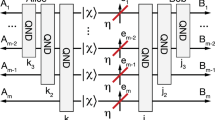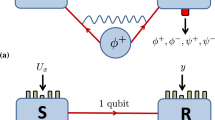Abstract
Entanglement distillation is an indispensable ingredient in extended quantum communication networks. Distillation protocols are necessarily non-deterministic and require advanced experimental techniques such as noiseless amplification. Recently, it was shown that the benefits of noiseless amplification could be extracted by performing a post-selective filtering of the measurement record to improve the performance of quantum key distribution. We apply this protocol to entanglement degraded by transmission loss of up to the equivalent of 100 km of optical fibre. We measure an effective entangled resource stronger than that achievable by even a maximally entangled resource passively transmitted through the same channel. We also provide a proof-of-principle demonstration of secret key extraction from an otherwise insecure regime. The measurement-based noiseless linear amplifier offers two advantages over its physical counterpart: ease of implementation and near-optimal probability of success. It should provide an effective and versatile tool for a broad class of entanglement-based quantum communication protocols.
This is a preview of subscription content, access via your institution
Access options
Subscribe to this journal
Receive 12 print issues and online access
$209.00 per year
only $17.42 per issue
Buy this article
- Purchase on Springer Link
- Instant access to full article PDF
Prices may be subject to local taxes which are calculated during checkout





Similar content being viewed by others
References
Heisenberg, W. Über den anschaulichen inhalt der quantentheoretischen kinematik und mechanik. Z. Phys. 43, 172–198 (1927).
Wootters, W. K. & Zurek, W. H. A single quantum cannot be cloned. Nature 299, 802–803 (1982).
Giovannetti, V., Lloyd, S. & Maccone, L. Advances in quantum metrology. Nature Photon. 5, 222–229 (2011).
Caves, C. M. Quantum limits on noise in linear amplifiers. Phys. Rev. D 26, 1817–1839 (1982).
Caves, C. M., Combes, J., Jiang, Z. & Pandey, S. Quantum limits on phase-preserving linear amplifiers. Phys. Rev. A 86, 063802 (2012).
Bennett, C. et al. Purification of noisy entanglement and faithful teleportation via noisy channels. Phys. Rev. Lett. 76, 722–725 (1996).
Horodecki, M., Horodecki, P. & Horodecki, R. Inseparable two spin-1/2 density matrices can be distilled to a singlet form. Phys. Rev. Lett. 78, 574–577 (1997).
Browne, D., Eisert, J., Scheel, S. & Plenio, M. Driving non-Gaussian to Gaussian states with linear optics. Phys. Rev. A 67, 062320 (2003).
Duan, L. M., Lukin, M. D., Cirac, J. I. & Zoller, P. Long-distance quantum communication with atomic ensembles and linear optics. Nature 414, 413–418 (2001).
Kimble, H. J. The quantum internet. Nature 453, 1023–1030 (2008).
Weedbrook, C. et al. Gaussian quantum information. Rev. Mod. Phys. 84, 621–669 (2012).
Eisert, J., Browne, D., Scheel, S. & Plenio, M. Distillation of continuous-variable entanglement with optical means. Ann. Phys. 311, 431–458 (2004).
Ralph, T. C. & Lund, A. P. Nondeterministic noiseless linear amplification of quantum systems in Proceedings of the 9th International Conference on Quantum Communication Measurement and Computing (ed. Lvovsky, A. I.) 155–160 (American Institute of Physics, 2009).
Ralph, T. C. Quantum error correction of continuous-variable states against gaussian noise. Phys. Rev. A 84, 022339 (2011).
Walk, N., Lund, A. P. & Ralph, T. C. Nondeterministic noiseless amplification via non-symplectic phase space transformations. New J. Phys. 15, 073014 (2013).
Marek, P. & Filip, R. Coherent-state phase concentration by quantum probabilistic amplification. Phys. Rev. A 81, 022302 (2010).
Fiurášek, J. Engineering quantum operations on traveling light beams by multiple photon addition and subtraction. Phys. Rev. A 80, 053822 (2009).
Xiang, G. Y., Ralph, T. C., Lund, A. P., Walk, N. & Pryde, G. J. Heralded noiseless linear amplification and distillation of entanglement. Nature Photon. 4, 316–319 (2010).
Ferreyrol, F. et al. Implementation of a nondeterministic optical noiseless amplifier. Phys. Rev. Lett. 104, 123603 (2010).
Ferreyrol, F., Blandino, R., Barbieri, M., Tualle-Brouri, R. & Grangier, P. Experimental realization of a nondeterministic optical noiseless amplifier. Phys. Rev. A 83, 063801 (2011).
Zavatta, A., Fiurášek, J. & Bellini, M. A high-fidelity noiseless amplifier for quantum light states. Nature Photon. 5, 52–60 (2010).
Osorio, C. I. et al. Heralded photon amplification for quantum communication. Phys. Rev. A 86, 023815 (2012).
Kocsis, S., Xiang, G. Y., Ralph, T. C. & Pryde, G. J. Heralded noiseless amplification of a photon polarization qubit. Nature Phys. 9, 23–28 (2012).
Mičuda, M. et al. Noiseless loss suppression in quantum optical communication. Phys. Rev. Lett. 109, 180503 (2012).
Usuga, M. A. et al. Noise-powered probabilistic concentration of phase information. Nature Phys. 6, 767–771 (2010).
Reid, M. D. et al. Colloquium: the Einstein–Podolsky–Rosen paradox: from concepts to applications. Rev. Mod. Phys. 81, 1727–1751 (2009).
Fiurášek, J. & Cerf, N. Gaussian postselection and virtual noiseless amplification in continuous-variable quantum key distribution. Phys. Rev. A 86, 060302 (2012).
Walk, N., Ralph, T. C., Symul, T. & Lam, P. K. Security of continuous-variable quantum cryptography with Gaussian postselection. Phys. Rev. A 87, 020303 (2013).
Hellwig, K. & Kraus, K. Operations and measurements. II. Commun. Math. Phys. 16, 142–147 (1970).
Ferreyrol, F., Spagnolo, N., Blandino, R., Barbieri, M. & Tualle-Brouri, R. Heralded processes on continuous-variable spaces as quantum maps. Phys. Rev. A 86, 062327 (2012).
Prugovečki, E. Information-theoretical aspects of quantum measurement. Int. J. Theor. Phys. 16, 321–331 (1977).
Busch, P. & Lahti, P. J. The determination of the past and the future of a physical system in quantum mechanics. Found. Phys. 19, 633–678 (1989).
Eisert, J., Scheel, S. & Plenio, M. Distilling Gaussian states with Gaussian operations is impossible. Phys. Rev. Lett. 89, 137903 (2002).
Fiurášek, J. Gaussian transformations and distillation of entangled gaussian states. Phys. Rev. Lett. 89, 137904 (2002).
Giedke, G. & Cirac, J. I. Characterization of Gaussian operations and distillation of Gaussian states. Phys. Rev. A 66, 032316 (2002).
Pegg, D., Phillips, L. & Barnett, S. Optical state truncation by projection synthesis. Phys. Rev. Lett. 81, 1604–1606 (1998).
Reid, M. D. Demonstration of the Einstein–Podolsky–Rosen paradox using nondegenerate parametric amplification. Phys. Rev. A 40, 913–923 (1989).
Duan, L. M., Giedke, G., Cirac, J. I. & Zoller, P. Inseparability criterion for continuous variable systems. Phys. Rev. Lett. 84, 2722–2725 (2000).
Reid, M. D. & Drummond, P. D. Quantum correlations of phase in nondegenerate parametric oscillation. Phys. Rev. Lett. 60, 2731–2733 (1988).
Blandino, R. et al. Improving the maximum transmission distance of continuous-variable quantum key distribution using a noiseless amplifier. Phys. Rev. A 86, 012327 (2012).
Lee, S.-Y., Ji, S.-W., Kim, H.-J. & Nha, H. Enhancing quantum entanglement for continuous variables by a coherent superposition of photon subtraction and addition. Phys. Rev. A 84, 012302 (2011).
Kim, H.-J., Lee, S.-Y., Ji, S.-W. & Nha, H. Quantum linear amplifier enhanced by photon subtraction and addition. Phys. Rev. A 85, 013839 (2012).
Barbieri, M. et al. Non-Gaussianity of quantum states: an experimental test on single-photon-added coherent states. Phys. Rev. A 82, 063833 (2010).
Zavatta, A., Viciani, S. & Bellini, M. Quantum-to-classical transition with single-photon-added coherent states of light. Science 306, 660–662 (2004).
Acknowledgements
The authors thank S. Rahimi-Keshari, R. Blandino and A. P. Lund for helpful discussions. This research is supported by the Australian Research Council (ARC) under the Centre of Excellence for Quantum Computation and Communication Technology (CE110001027). P.K.L. is an ARC Future Fellow.
Author information
Authors and Affiliations
Contributions
N.W. and T.C.R. developed the theory. H.M.C., S.M.A., J.J., S.H., T.S. and P.K.L. conceived and conducted the experiment. H.M.C., S.M.A. and N.W. analysed the data. H.M.C., N.W. and S.M.A. drafted the initial manuscript. P.K.L., T.C.R. and T.S. planned and supervised the entire project. All authors discussed the results and commented on the manuscript.
Corresponding author
Ethics declarations
Competing interests
The authors declare no competing financial interests.
Supplementary information
Supplementary information
Supplementary information (PDF 464 kb)
Rights and permissions
About this article
Cite this article
Chrzanowski, H., Walk, N., Assad, S. et al. Measurement-based noiseless linear amplification for quantum communication. Nature Photon 8, 333–338 (2014). https://doi.org/10.1038/nphoton.2014.49
Received:
Accepted:
Published:
Issue Date:
DOI: https://doi.org/10.1038/nphoton.2014.49
This article is cited by
-
Quantum channel correction outperforming direct transmission
Nature Communications (2022)
-
Distillation of Gaussian Einstein-Podolsky-Rosen steering with noiseless linear amplification
npj Quantum Information (2022)
-
Sudden death and revival of Gaussian Einstein–Podolsky–Rosen steering in noisy channels
npj Quantum Information (2021)
-
A high-fidelity heralded quantum squeezing gate
Nature Photonics (2020)
-
Security Analysis of Practical Continuous-Variable Quantum Key Distribution Using a Heralded Noiseless Amplifier
International Journal of Theoretical Physics (2019)



